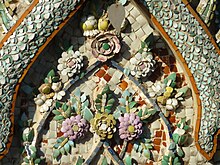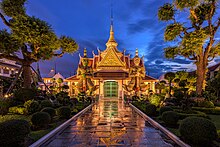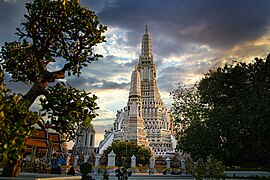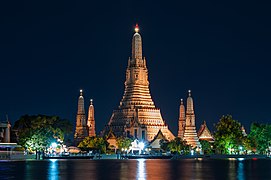User:HMGiovanniV/工作3
| Wat Arun Ratchawararam | |
|---|---|
| Temple of Dawn | |
 The temple, seen from across the river in 2021 | |
| 基本信息 | |
| 国家 | Thailand |
| 坐标 | 13°44′37″N 100°29′20″E / 13.74361°N 100.48889°E |
| 宗教 | Theravada Buddhism |
| 官方网站 | www |
| 竣工 |
|
| 地圖 | |
 | |
Wat Arun Ratchawararam Ratchawaramahawihan (脚本错误:函数“langx”不存在。 ⓘ ) or Wat Arun (th, "Temple of Dawn") is a Buddhist temple (wat) in the Bangkok Yai district of Bangkok, Thailand. It is situated on Thonburi on the west bank of the Chao Phraya River. The temple derives its name from the Hindu god Aruṇa,[1] often personified as the radiations of the rising sun. Wat Arun is among the best known of Thailand's landmarks.[2] Although the temple has existed since at least the 17th century, its distinctive prang (spire) was built in the early 19th century during the reigns of Rama II and Rama III.
History
[编辑]A Buddhist temple had existed at the site of Wat Arun since the time of the Ayutthaya Kingdom, prior to the reign of King Narai.[3]:4 It was then known as Wat Bang Makok[4][3]:1 which was later shortened to Wat Makok,[3]:1 after the village of Bang Makok in which it was built (makok is the Thai name for the Spondias pinnata plant). According to the historian Prince Damrong Rajanubhab, the temple was shown in French maps during the reign of Narai (1656–88), drew by Claude de Forbin and de Lamare.[3]:2–3
The temple was renamed Wat Chaeng by Taksin (1767–82)[3]:2 when he established his new capital of Thonburi near the temple, following the fall of Ayutthaya.[6] It is believed that Taksin vowed to restore the temple after passing it at dawn. The temple enshrined the Emerald Buddha image before it was transferred to Wat Phra Kaew on the river's eastern bank in 1785.[7] The temple was on the grounds of the royal palace during Taksin's reign, before his successor, Rama I (1782–1809), moved the palace to the other side of the river.[2] It was abandoned until the reign of Rama II (1809–24), who had the temple restored and had begun plans to raise the main pagoda to 70 m.[2] The work on the pagoda commenced during the reign of Rama III (1824–51). The main prang was completed in 1851, after nine years of continued construction.[8]

In 1858, Henri Mouhot, a French expeditioner, recorded the detailed observations of Wat Chang (literally Wat Chaeng, Wat Arun) in his travel journals Voyage dans les royaumes de Siam, de Cambodge, de Laos when he had journeyed to Siam.
Nous devons ajouter que la plus belle pagode de Bangkok, celle de Wat-Chang, n’est cependant pas renfermée dans l’enceinte du palais, mais s’élève vis-à-vis, sur la rive droite du Ménam. Sa flèche, haute de deux cents pieds, est le premier indice de la capitale qu’aperçoit le voyageur qui remonte le fleuve en venant de la mer.[9]
(Translation): Let me add here that Wat Chaeng, the most beautiful temple in Bangkok, is not located in the palace grounds but stands majestically on the right bank of the river. The spire of the pagoda, which is over 200 feet in height, is the first sign to travelers sailing upstream from the mouth of the river that they have arrived in the capital.
——Henri MOUHOT (1826–61),Voyage dans les royaumes de Siam, de Cambodge, de Laos, 1868.

The temple underwent major restorations during the reign of Chulalongkorn (Rama V, 1868–1910) and in 1980, prior to the bicentenary celebration of Bangkok's foundation.[3]:23 The most extensive restoration work on the prang was undertaken from 2013 to 2017, during which a substantial number of broken tiles were replaced and lime plaster was used to re-finish many of the surfaces (replacing the cement used during earlier restorations). As the work neared its end in 2017, photographs of the results drew some criticism for the temple's new appearance, which seemed white-washed compared to its previous state. The Fine Arts Department defended the work, stating that it was carefully done to reflect the temple's original appearance.[10][11]
Architecture
[编辑]
The main feature of Wat Arun is its central prang, which is encrusted with colourful porcelain.[12] This is interpreted as a stupa-like pagoda encrusted with coloured faience.[13] The height is reported by different sources as between 66.8 m (219 ft) and 86 m (282 ft). The corners are surrounded by four smaller satellite prang. The prang are decorated by shells of Mauritia mauritiana and bits of porcelain, which had previously been used as ballast by boats coming to Bangkok from China.[14] Prince Narisara Nuwattiwong said that both prang (spire) and vihara (main hall) appeared today; they were the original works of the Department of Ten Crafts in the Ayutthaya period.[15]
The central prang is topped with a seven-pronged trident, referred to by many sources as the "Trident of Shiva".[16] Around the base of the prang are various figures of ancient Chinese soldiers and animals. Over the second terrace are four statues of the Hindu god Indra riding on Erawan.[17] In Buddhist iconography, the central prang is considered to have three symbolic levels—base for Traiphum indicating all realms of existence, middle for Tavatimsa, the Tusita Heaven where all desires are gratified, and the top denoting Devaphum indicating six heavens within seven realms of happiness.[17] At the riverside are six pavilions (sala) in the Chinese style. The pavilions are made of green granite and contain landing bridges.

Next to the prang is the Ordination Hall with a Niramitr Buddha image supposedly designed by Rama II. The front entrance of the Ordination Hall has a roof with a central spire, decorated in coloured ceramic and stuccowork sheathed in coloured china. Inside, there is a grand altar with a red, grey and white marble decoration. There are two demons, or temple guardian figures, in front.[17] The murals were created during the reign of Rama V.[17]
Cosmology
[编辑]The central prang symbolises Mount Meru of the Hindu cosmology.[17] The satellite prang are devoted to the wind god, Phra Phai. The demons (yaksha) at the entranceway to the ubosot are from the Ramakien. The white figure is named Sahassa Deja and the green one is known as Thotsakan, the Demon Rāvana from Ramayana.
Travel
[编辑]Wat Arun can be accessed through the Chao Phraya River, and ferries travel across the river towards the Maharaj pier. For foreigners, the temple charges an entrance fee of 200 baht (as of March 2024). During Kathina, the king travels to Wat Arun in a procession of royal barges to present new robes to the monks there.
Gallery
[编辑]-
The prang, seen from within the temple grounds (2020)
-
View of the river from the main prang (2013)
-
The vihara, seen from the main prang (2014)
-
Buddha statues in the cloister (2017)
-
The ordination hall (2018)
-
The principal Buddha image, in the ordination hall (2018)
-
The temple lit up at night (2017)
-
Frontal view of the prang at night (2017)
See also
[编辑]Citations
[编辑]- ^ Angova, Aneta. Wat Arun - The Temple of Dawn. watarun.net.
- ^ 2.0 2.1 2.2 Liedtke 2011, p. 57
- ^ 3.0 3.1 3.2 3.3 3.4 3.5 The Fine Arts Department of Thailand. (1978). Prawat wat Arun Rātchawarārām [History of Wat Arun] ประวัติวัดอรุณราชวราราม (in Thai). (2nd ed.). Bangkok : The Fine Arts Department Thailand. p. 4.
- ^ Department of Religious Affairs, Ministry of Education Thailand. (1981). Prawat wat samkhan thāng Phraphuttha Sātsanā tō̜n 1 [History of important Buddhist temples in Thailand Chapter 1] ประวัติวัดสำคัญทางพระพุทธศาสนา ตอน ๑ (in Thai). Bangkok : Ministry of Education Thailand. p. 18.
- ^ Suriyothin, Phanchalath et al. (2022). History of Wat Arun Ratchawararam. Arun-Sawas.com : The Research on Creating electronic media on cultural heritage to promote tourism at Wat Arun Ratchawararam. Bangkok: Faculty of Architecture Chulalongkorn University.
- ^ ประวัติวัดอรุณราชวราราม ราชวรมหาวิหาร [History of Wat Arun]. watarun.org. [28 September 2012] (泰语).
- ^ Spooner 2011, p. 100
- ^ พระปรางค์ (Phra Prang). วัดอรุณราชวราราม ราชวรมหาวิหาร (Wat Arun Ratchawaram). (原始内容存档于Nov 2, 2022).
- ^ MOUHOT, HENRI. and LANOYE, FERDINAND DE. (1868). Voyage dans les royaumes de Siam, de Cambodge, de Laos et autres parties centrales de l'Indo-Chine : relation extraite du journal et de la correspondance de l'auteur. Paris: Librai de L. Hachette & Cie. p. 24.
- ^ Rojanaphruk, Pravit. New Dawn or Letdown? Iconic Temple Makeover Gets Mixed Reviews (Photos). Khaosod English. 19 August 2017 [7 September 2017].
- ^ Fine Arts stands by Wat Arun stupa repair effort. Bangkok Post. 17 August 2017 [7 September 2017].
- ^ Emmons 2008, p. 17
- ^ Norwich 2001, p. 266
- ^ Ridout 2009
- ^ Narisara Nuwattiwong, and Damrong Rajanubhab. (1962). San Somdet Vol. I [Letters between Their late Royal Highnesses Prince Naris and Prince Damrong Vol. I] สาส์นสมเด็จ เล่ม ๑ (in Thai). Bangkok : Ong Karn Kha Kurusapha. p. 42.
- ^ Wat Arun
- ^ 17.0 17.1 17.2 17.3 17.4 Emmons 2008, pp. 26-27
General references
[编辑]- Emmons, Ron, Top 10 Bangkok, New York: DK, 2008, ISBN 978-0-7566-8850-9
- Liedtke, Marcel, Thailand- The East (English Edition), Norderstedt: Books on Demand GmbH, 2011, ISBN 978-3-8423-7029-6
- Norwich, John Julius, Great architecture of the world, USA: Da Capo Press Inc., 2001, ISBN 0-306-81042-5
- Ridout, Lucy; Gray, Paul, The Rough Guide to Thailand's Beaches & Islands, India: Rough Guides, 2009, ISBN 978-1-84836-091-4
- Spooner, Andrew; Borrowman, Hana; Baldwin, William, Footprint Thailand, UK: footprintbooks.com, 2011, ISBN 978-1-904777-94-6


![French map showing the location of Wat Makok (now Wat Arun) from Histoire de la Révolution de Siam arrivée en l'année 1688, by Jean Vollant des Verquains (1688) reign of King Narai.[5]](http://upload.wikimedia.org/wikipedia/commons/thumb/3/3b/Siege_of_Bangkok.JPG/220px-Siege_of_Bangkok.JPG)











